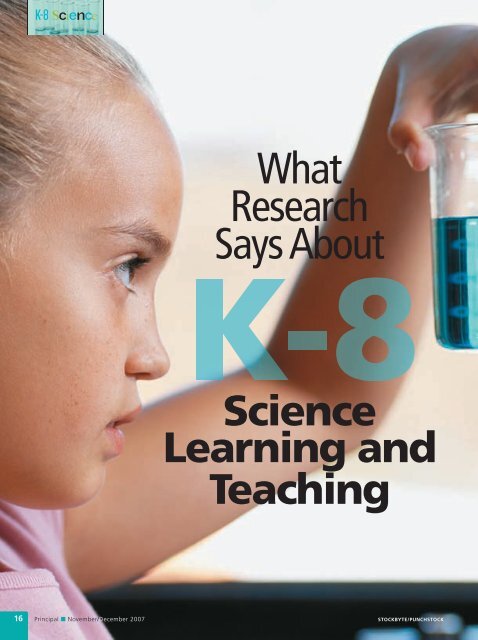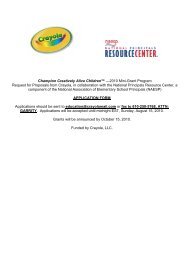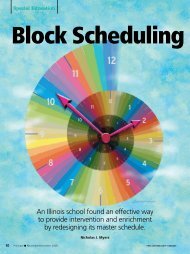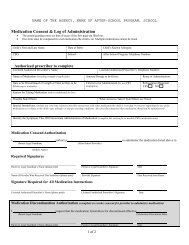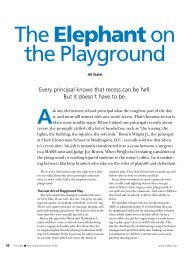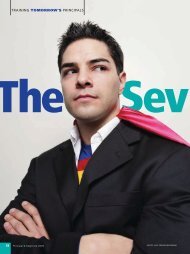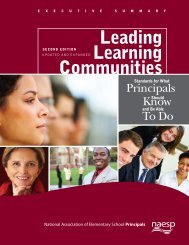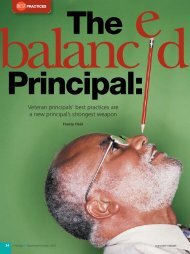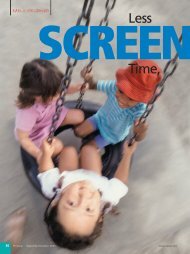What Research Says About K-8 Science Learning and Teaching
What Research Says About K-8 Science Learning and Teaching
What Research Says About K-8 Science Learning and Teaching
Create successful ePaper yourself
Turn your PDF publications into a flip-book with our unique Google optimized e-Paper software.
THE FISCHLER SCHOOL › YOU › THE LIVES YOU TOUCH › THE LIVES THEY TOUCH ›<strong>What</strong> you learn here <strong>and</strong> how you learn it will not only transform your life, but thelives of everyone around you. When we opened our doors more than 35 years ago,we shattered the barriers of traditional learning, causing a ripple effect that canstill be felt today. We’re the Fischler School of Education <strong>and</strong> Human Services.Our ideas, our approach, <strong>and</strong> our programs inspire educational leaders to inspirethe people around them to move the world.cause an effect ›www.FischlerSchool.nova.edu800-986-3223Nova Southeastern University admits students of any race, color, sexual orientation, <strong>and</strong> national or ethnic origin. ■ NovaSoutheastern University is accredited by the Commission on Colleges of the Southern Association of Colleges <strong>and</strong> Schools(1866 Southern Lane, Decatur, Georgia 30033-4097, Telephone number: 404-679-4501) to award associate’s, bachelor’s,master’s, educational specialist, <strong>and</strong> doctoral degrees.08-321a-07KAR
Tensions with EstablishedPracticesWe face challenges implementing theTSTS recommendations because someestablished school <strong>and</strong> classroom practicescreate tensions. One tension is thatthe current state of affairs finds scienceinstruction disconnected <strong>and</strong> frequentlyseparating the teaching of conceptsfrom the teaching of processes, skills,<strong>and</strong> practices. For example, in many K-8science inquiry programs the emphasisis on domain-general skills (e.g., distinguishobservations from inferences)without any attention being given tohow these skills relate to the disciplinaryknowledge under study—processeslearning goals are separated from theconceptual learning goals.Then there is the tension of far toomany objectives, benchmarks, <strong>and</strong>st<strong>and</strong>ards at individual grade levels <strong>and</strong>grade b<strong>and</strong>s. This is the recognizedproblem of U.S. science curriculabeing a “mile wide <strong>and</strong> an inch deep.”Many existing curricula, st<strong>and</strong>ards,<strong>and</strong> assessments in the U.S. comprisetoo many disconnected topics givenequal priority. The important unifyingthemes <strong>and</strong> principles of science aregetting lost in favor of concept coverage.Core knowledge (e.g., propertiesof matter), science practices (e.g.,building <strong>and</strong> refining models thataccount for evidence), <strong>and</strong> scientificdiscourses (e.g., collecting, analyzing,<strong>and</strong> representing data from observations<strong>and</strong> experiments) are not beingcarried over from one school year tothe next, nor even from one moduleto the next within a school year. Coreknowledge <strong>and</strong> practices should becentral to science curriculum content,accessible to students in kindergarten,<strong>and</strong> have potential for sustained explorationacross K-8.Conceptual knowledge, scientificreasoning, underst<strong>and</strong>ing how scientificknowledge is produced, <strong>and</strong> participatingin science all represent elementsthat are intimately intertwinedin the doing of science. Another tensionfor implementing the TSTS recommendationsis too much sequencingvariation in the implementationof the st<strong>and</strong>ards. The use of modularunits shared across classrooms, <strong>and</strong>that jump from one topic to another,work against the development ofcoherent learning progressions. Modulesdo provide flexibility for sharingmaterials <strong>and</strong> textbooks among teachers<strong>and</strong> across classrooms, but withoutcareful consideration the enactedsequence can confuse rather thanenlighten young science learners.The research on young children’sthinking suggests that children arecapable of abstract reasoning <strong>and</strong>theory building from very early agesin select domains. The researchon infants <strong>and</strong> pre-K children, <strong>and</strong>research on children’s alternative conceptions,demonstrates that studentsdo arrive at school with core knowledge,<strong>and</strong> as they experience the worldaround them they do develop explanations—albeitnaïve ones at times. 20 Principal n November/December 2007www.naesp.org
Sequence variation can lead to teachershaving too strong a focus on “fixing”students’ misconceptions that can,in turn, lead teachers to overlook theproductive “half-baked” ideas <strong>and</strong> intuitionsthat can be leverage points forlearning across coordinated sequences.<strong>Research</strong> on early childhood learningreported in TSTS shows that some areasof knowledge provide more robustfoundations to build on than otherswhen thinking about the sequencing ofcurriculum. Promising core knowledgedomains for the early development(pre-K-2) of reasoning include:n Physical mechanics (locating patternsbased on property size, shape, <strong>and</strong>weight; describing <strong>and</strong> representingmechanisms for the causes);n Biology (differentiating betweenanimate <strong>and</strong> inanimate; describing<strong>and</strong> representing biological processessuch as digestion, growth, reproduction,<strong>and</strong> sickness);n Matter <strong>and</strong> substance (measurement<strong>and</strong> representation of macroscopicproperties <strong>and</strong> attributes); <strong>and</strong>n Naïve psychology (engaging in meaning-makingwith others, recognizingthat beliefs of others may be differentfrom your own <strong>and</strong> for good reasons).Another tension recognized in theTSTS report is that scientific argumentis rare in science classrooms, althoughcentral to science. We find that teachingfocuses on recall rather than modelbasedreasoning. The classroom normsof teachers <strong>and</strong> textbooks providinganswers do not facilitate the buildingof scientific models from evidence. Scientificargumentation, when carefullysupported <strong>and</strong> mediated by classroomteachers, can effectively engage K-8 studentsin examining the following:n <strong>What</strong> are the measurements/observationsone needs to take to get data forthe question or problem at h<strong>and</strong>?n <strong>What</strong> are the data worth keeping <strong>and</strong>using as evidence?n How can the evidence be examined<strong>and</strong> analyzed to locate patterns <strong>and</strong>trends?n How can models be built to constructexplanations <strong>and</strong> devise further teststo refine the models <strong>and</strong>/or comparemodels with alternative <strong>and</strong> establishedscientific theories?Recommendations for Policy,Practice, <strong>and</strong> <strong>Research</strong>With respect to st<strong>and</strong>ards, curricula,<strong>and</strong> assessments, the TSTS reportrecommends:n Revising st<strong>and</strong>ards, curricula, <strong>and</strong>assessments to reflect a new underst<strong>and</strong>ingof children’s thinking;n Structuring the next generation ofst<strong>and</strong>ards <strong>and</strong> curricula to identifya few core ideas in a discipline <strong>and</strong>articulate how these ideas can begrown in a cumulative manner overgrades K-8; <strong>and</strong>n Presenting science as a process ofbuilding theories <strong>and</strong> models usingwww.naesp.org Principal n November/December 2007 21
evidence, checking them for internalconsistency <strong>and</strong> coherence, <strong>and</strong> testingthem empirically.Regarding instruction <strong>and</strong> how toteach, the TSTS report recommends that:n <strong>Science</strong> instruction should provideopportunities for students to engagein all four str<strong>and</strong>s of proficiency;n State <strong>and</strong> local leaders in educationshould provide teachers with models ofclassroom instruction that incorporatethe four str<strong>and</strong>s of proficiency; <strong>and</strong>n Policymakers, educational leaders,<strong>and</strong> administrators need to ensurethat adequate time <strong>and</strong> resources areprovided, teachers have adequateknowledge of science content, <strong>and</strong>adequate professional development isprovided.Professional development is neededfor supporting effective science instruction<strong>and</strong> the TSTS report recommendsthat:n State <strong>and</strong> local systems should ensurethat all K-8 teachers experience science-specificprofessional developmentin preparation <strong>and</strong> inductionprograms <strong>and</strong> while in service;n University-based courses for teacherc<strong>and</strong>idates <strong>and</strong> teachers’ ongoingopportunities to learn science in serviceshould mirror the opportunitiesthey will need to provide for theirstudents; <strong>and</strong>n Federal <strong>and</strong> state agencies that fundproviders for professional developmentshould design funding programsthat require applicants toincorporate models of instruction thatcombine the four str<strong>and</strong>s of proficiency,focus on core ideas in science,<strong>and</strong> enhance teachers’ knowledge.The TSTS executive summary <strong>and</strong>full report includes 14 conclusionsacross the categories of learning <strong>and</strong>learners, curriculum <strong>and</strong> instruction,<strong>and</strong> teachers <strong>and</strong> schools. Implementationof the recommendations listedabove will help address concerns aboutattracting <strong>and</strong> retaining students toSTEM disciplines. Focusing on theTSTS research conclusions will facilitatea reform of K-8 science curricula,st<strong>and</strong>ards, <strong>and</strong> assessments. PRichard A. Duschl is chair of theCommittee on <strong>Science</strong> <strong>Learning</strong>,Kindergarten Through Eighth Grade,<strong>and</strong> professor of science education atRutgers University. His e-mail address isrduschl@rci.rutgers.edu.Andrew W. Shouse <strong>and</strong> Heidi A.Schweingruber are co-study directorsof the Committee on <strong>Science</strong> <strong>Learning</strong>,Kindergarten Through Eighth Grade,<strong>and</strong> senior program officers with theBoard on <strong>Science</strong> Education at theNational <strong>Research</strong> Council. Their e-mailaddresses are ashouse@nas.edu <strong>and</strong>aschweingruber@nas.edu.ReferencesNational Center on Education <strong>and</strong> theEconomy. (2007). Tough choices or toughtimes: The report of the New Commission onthe Skills of the American Workforce. SanFrancisco: Jossey-Bass/John Wiley & Sons.National <strong>Research</strong> Council.(2006). Risingabove the gathering storm: Energizing<strong>and</strong> employing America for a brighterfuture. Washington, DC: The NationalAcademies Press.National <strong>Research</strong> Council. (2007). Takingscience to school: <strong>Learning</strong> <strong>and</strong> teachingscience in grades K-8. Washington, DC:The National Academies Press.Web ResourcesInterested individuals can orderor download the “Taking <strong>Science</strong> toSchool: <strong>Learning</strong> <strong>and</strong> <strong>Teaching</strong> <strong>Science</strong>in Grades K-8” report <strong>and</strong> executivesummary.http://newton.nap.edu/catalog/11625.htmlReady, Set, <strong>Science</strong>: Putting <strong>Research</strong> toWork in the K-8 <strong>Science</strong> Classroom is anaccount of the groundbreaking <strong>and</strong>comprehensive synthesis of researchinto teaching <strong>and</strong> learning K-8 science.The book is scheduled for release inOctober 2007 <strong>and</strong> will be downloadable.http://books.nap.edu/catalog.php?record_id=11882The U.S. Department of Education’sFREE (Federal Resources forEducational Resources) site offersnumerous science resources.www.free.ed.gov/subjects.cfm?subject_id=4122 Principal n November/December 2007www.naesp.org
SchoolFurnitureIn Stock <strong>and</strong> Ready to Ship!When you need furniture for yourschool, Virco is ready to respond.From student chairs <strong>and</strong> desks tocafeteria tables, Virco has theindustry’s largest selection ofready-to-ship education solutionsto start the year off right. Andordering Virco furniture is easy.You can use our U.S. Communitiescontract, which gives you quickaccess to great Virco furnitureprices without the hassles ofthe bidding process.ZUMA ® SeriesHundreds of Virco furniture models arenow certified according to the stringentGREENGUARD ® indoor air qualityst<strong>and</strong>ard for children <strong>and</strong> schools,including all ZUMA ® chairs <strong>and</strong> desks.classroom solutionstask seatingcafeteria tablesearly learning furnitureFor more information, call us today at 800-448-4726,Virco is a proud sponsor of:or visit our website at www.virco.com. Registeredcustomers can now BUY ONLINE at www.virco.com.Register today by calling 800-448-4726.- equipment for educators ©2007 Virco Inc. REF# 07107


